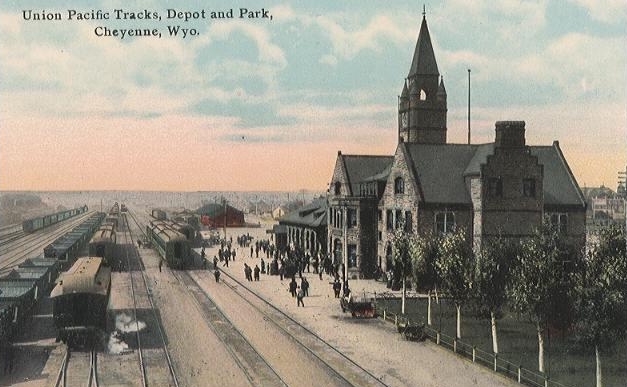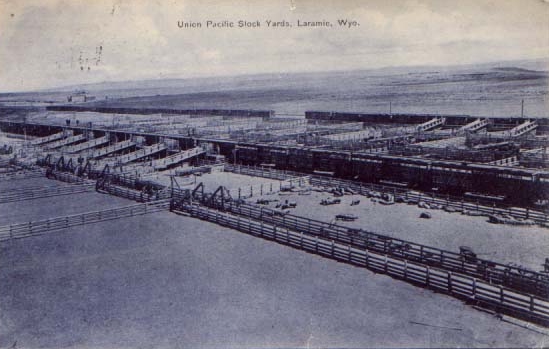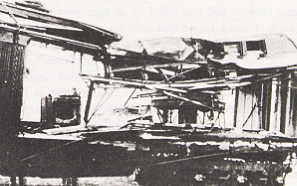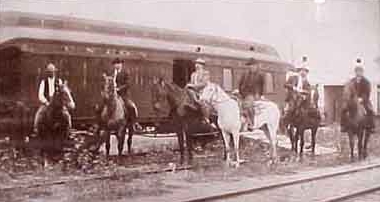|

Union Pacific Depot, Cheyenne, 1910

Laramie Stockyards, 1910
Just as the stages carrying gold on the Deadwood Trail attracted road agents, the
railroad attracted the attention of train robbers, the most prominent being the Wild
Bunch.  Below right is pictured the
remains of the express car of the Overland Flyer blown up by the gang of Harvey Logan, aka
"Kid Curry", Lonny Logan, Ben Kilpatrick, Elza Lay and Ben Benson on June 2, 1899,
near Wilcox, Wyoming. Some question exists as to whether the Butch Cassidy directly participated,
although it is generally accepted that he was involved in the planning. Positive identification of
all members was not possible since they wore face masks made from white napkins
possibly stolen from a Harvey House Restaurant. The gang flagged down the Flyer and ordered the engineer to pull the train
ahead where the gang separated the express car from the rest of the train with
explosives. After surrounding the car, the attendant by the name of Woodcock was
ordered by the gang to open the door. When he refused, the car was blown up. Woodcock, from the
concussion received in the explosion, was unable to remember the combination to the safe.
Whereupon, the safe was
blown up and robbed of $30,000. During the pursuit by a posse Sheriff Joe Hazen was
shot. The gang was, however, Below right is pictured the
remains of the express car of the Overland Flyer blown up by the gang of Harvey Logan, aka
"Kid Curry", Lonny Logan, Ben Kilpatrick, Elza Lay and Ben Benson on June 2, 1899,
near Wilcox, Wyoming. Some question exists as to whether the Butch Cassidy directly participated,
although it is generally accepted that he was involved in the planning. Positive identification of
all members was not possible since they wore face masks made from white napkins
possibly stolen from a Harvey House Restaurant. The gang flagged down the Flyer and ordered the engineer to pull the train
ahead where the gang separated the express car from the rest of the train with
explosives. After surrounding the car, the attendant by the name of Woodcock was
ordered by the gang to open the door. When he refused, the car was blown up. Woodcock, from the
concussion received in the explosion, was unable to remember the combination to the safe.
Whereupon, the safe was
blown up and robbed of $30,000. During the pursuit by a posse Sheriff Joe Hazen was
shot. The gang was, however, able to excape, albeit, on foot, they having lost
their horses to the pursuing posse, photo to left. able to excape, albeit, on foot, they having lost
their horses to the pursuing posse, photo to left.
On August 29, 1900, members of the Wild Bunch, using the same modus operandi
robbed the Union Pacific No. 3 train near Tipton, Wyoming of $50,000. As fate would have it,
Woodcock was again the express car attendant. This time he opened the door. On
July 3, 1901, members of the Wild Bunch blew up the Adams Express car on the Great
Northern Flyer near Wagner, Montana, getting $40,000.
Lonnie Logan was killed by a posse at Dodson, Kansas (now a part of Kansas City), on
February 28, 1900. Robert E. "Bob" Lee, aka Bob Curry was sent to prison for passing bank notes
stolen in the Wilcox robbery. Debate still rages as to the fate of Butch and
Sundance; that is, were they the Yanqui banditos killed in Peru, or did they
ultimately return to the U.S.
More railroad photos are on the Laramie, Encampment, Rawlins, and Green River Pages.
|